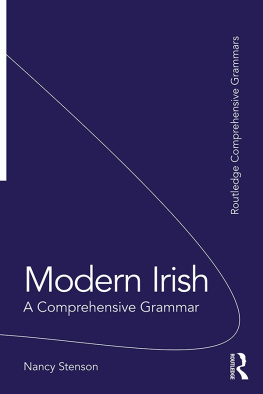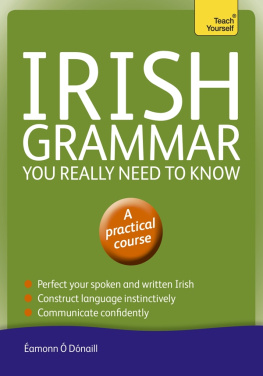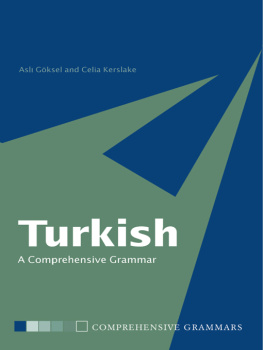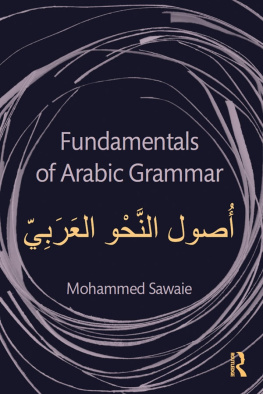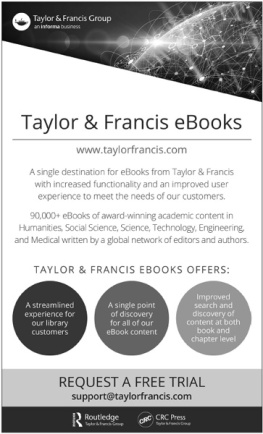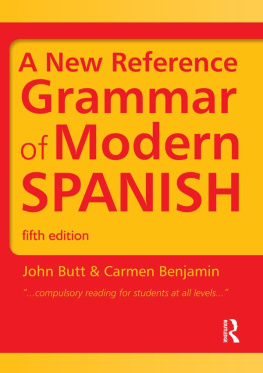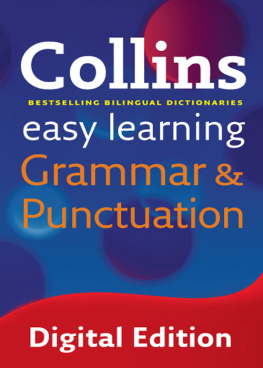Modern Irish
Modern Irish: A Comprehensive Grammar is a complete reference guide to modern Irish grammar, providing a thorough overview of the language.
Key features include:
- highly systematic coverage of all levels of structure: sound system, word formation, sentence construction and connection of sentences
- authentic examples and English translations which provide an accessible insight into the mechanics of the language
- an extensive index, numbered sections, cross-references and summary charts which provide readers with easy access to the information
Modern Irish: A Comprehensive Grammar is an essential reference source for the learner and user of Irish. It is ideal for use in schools, colleges, universities, and adult classes of all types.
Nancy Stenson is Professor Emerita at the University of Minnesota. She specializes in Irish and Celtic linguistics and was co-editor of the Journal of Celtic Language Learning from 1995 to 2007.
Routledge Comprehensive Grammars
Titles in this series:
Kazakh
A Comprehensive Grammar
Raihan Muhamedowa
Panjabi
A Comprehensive Grammar
Mangat Bhardwaj
French Creoles
A Comprehensive Grammar
Anand Syea
Dutch
A Comprehensive Grammar, 3rd Edition
Bruce Donaldson
Finnish
A Comprehensive Grammar
Fred Karlsson
Persian
A Comprehensive Grammar
Saeed Yousef
Norwegian
A Comprehensive Grammar
Philip Holmes, Hans-Olav Enger
Korean
A Comprehensive Grammar, 2nd edition
Jaehoon Yeon, Lucien Brown
Modern Irish
A Comprehensive Grammar
Nancy Stenson
Lithuanian
A Comprehensive Grammar
Meilut Ramonien, Joana Pribuauskait, Jogil Teresa Ramonait and Loreta Vilkien
For more information on this series, please visit: www.routledge.com/languages/series/SE0550
First published 2020
by Routledge
2 Park Square, Milton Park, Abingdon, Oxon OX14 4RN
and by Routledge
52 Vanderbilt Avenue, New York, NY 10017
Routledge is an imprint of the Taylor & Francis Group, an informa business
2020 Nancy Stenson
The right of Nancy Stenson to be identified as author of this work has been asserted by her in accordance with sections 77 and 78 of the Copyright, Designs and Patents Act 1988.
All rights reserved. No part of this book may be reprinted or reproduced or utilised in any form or by any electronic, mechanical, or other means, now known or hereafter invented, including photocopying and recording, or in any information storage or retrieval system, without permission in writing from the publishers.
Trademark notice: Product or corporate names may be trademarks or registered trademarks, and are used only for identification and explanation without intent to infringe.
British Library Cataloguing-in-Publication Data
A catalogue record for this book is available from the British Library
Library of Congress Cataloging-in-Publication Data
Names: Stenson, Nancy, author.
Title: Modern Irish : a comprehensive grammar / Nancy Stenson.
Description: New York : Taylor & Francis, 2019. |
Series: Routledge comprehensive grammars | Includes bibliographical references and index.
Identifiers: LCCN 2019024730 (print) | LCCN 2019024731 (ebook) | ISBN 9781138236516 (hardback) | ISBN 9781138236523 (paperback) | ISBN 9781315302034 (ebook)
Subjects: LCSH: Irish languageGrammar.
Classification: LCC PB1223 .S755 2019 (print) | LCC PB1223 (ebook) | DDC 491.6/25dc23
LC record available at https://lccn.loc.gov/2019024730
LC ebook record available at https://lccn.loc.gov/2019024731
ISBN: 978-1-138-23651-6 (hbk)
ISBN: 978-1-138-23652-3 (pbk)
ISBN: 978-1-315-30203-4 (ebk)
To my students and my teachers
Figures
Tables
No book is done in isolation. I am grateful first to the many people over the years who contributed to my learning and understanding of Irish, from my first teacher, the late Father Sen Sweeney, to the many people from whom I learned the language in the Gaeltacht, especially the community of Rth Chairn, County Meath. To them I owe an enormous debt and am grateful for their years of assistance and friendship. I also learned much from my students over the years and I thank them for keeping me on my toes and for wondering about aspects of the language that hadnt occurred to me until they asked.
Several people have read earlier drafts of this manuscript and made valuable suggestions and corrections that have helped improve the clarity and accuracy of the grammar. Thanks for this assistance to Will Kenny, Ann Mulkern, and Mary Roguski. I am also immensely grateful to Pdhraic Ciardha for his native intuitions and several insightful discussions of points of Irish grammar. Needless to say, none of these are responsible for any remaining errors. Samantha Vale Noya and Rosie McEwan at Routledge have provided valuable technical advice at every step, as has copy-editor Dan Shutt.
I would also like to thank the Dublin Institute for Advanced Studys School of Celtic Studies for financial and moral support over many years of research on Irish, most recently for the use of their comprehensive library of Irish materials as I completed and revised this book.
Some chapters of the grammar that follows borrow from my previous books, Basic Irish and Intermediate Irish, published by Routledge in 2008. The material used includes primarily introductory wording for several chapters, some examples, and certain tables and figures that originally appeared in those books.
Examples provided are primarily drawn from my fieldwork over many years in several Gaeltacht communities, especially in Counties Meath and Galway, and occasionally from television or radio broadcasts, and traditional folk literature. These include a few sources included in the main references, as well as other grammars and dictionaries, novels, histories and short stories, which are listed separately as data sources at the end of the reference section.
Irish Gaelic, or Irish, as it is known in Ireland, is one of the six Insular Celtic languages that have survived to modern times. The modern Celtic languages fall into two branches; Irish is a member of the Goidelic (or Gaelic) branch, which also includes Scottish Gaelic and Manx Gaelic, the latter currently enjoying a revival after the death of the last native speaker in the 1970s. The three Goidelic languages are all forms of Gaelic (which had a common written history until the sixteenth century), but they are generally referred to as Irish, (Scottish) Gaelic, and Manx, respectively. The Brythonic (or Brittanic, or British) branch of the family consists of Welsh, Breton, and Cornish (also undergoing a revival since the death of the last monolingual in the eighteenth century). All these languages are in a precarious position, with shrinking numbers of native speakers in the communities that have survived to the current century, extreme pressure from the majority language of the region (French in the case of Breton, English in the others) and variable, often limited, support from national authorities. Of all of them, Irish appears on the surface to be in the strongest position for several reasons. Since the 1920s, it has enjoyed official status within the Irish State. It is designated in the Constitution of Ireland as the first official language (English being the second) and is a required subject of study in all primary and secondary schools in the Republic of Ireland. A passing grade on the national school-leaving exams is required for matriculation at campuses of the National University of Ireland, and knowledge of Irish is an important skill for employment in parts of the Civil Service and in teaching. Censuses continue to show growth in the number of respondents claiming ability to speak Irish, although not all these speakers necessarily use the language on a regular basis. Irish is also, uniquely among Celtic languages, a working language of the European Union.

